1. Vibration Control, Noise Control, Shock Control of Space Structures
We have developed vibration control, acoustic control, and shock control for space structures such as space stations, lunar bases, and artificial satellites.
In space, sufficient of power supply is not expected.
Thus, an innovative method is required to suppress structural vibration using a self-powered control device. Our laboratory focuses on a truss structure that forms a structural member for next-generation space stations.
We have installed a truss structure in our laboratory, which is employed for proof experiments.
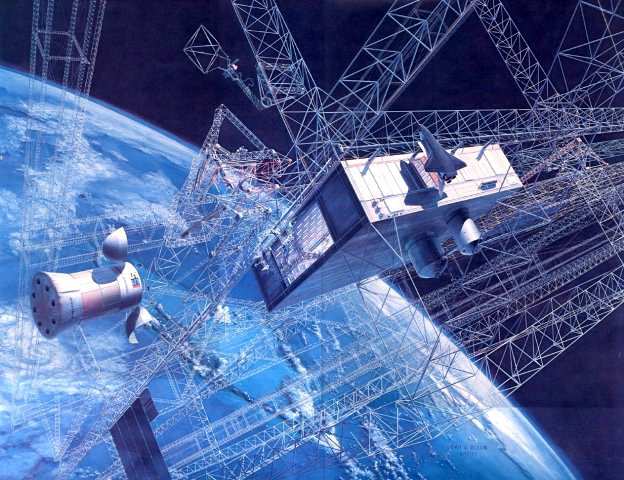
Next-generation space station
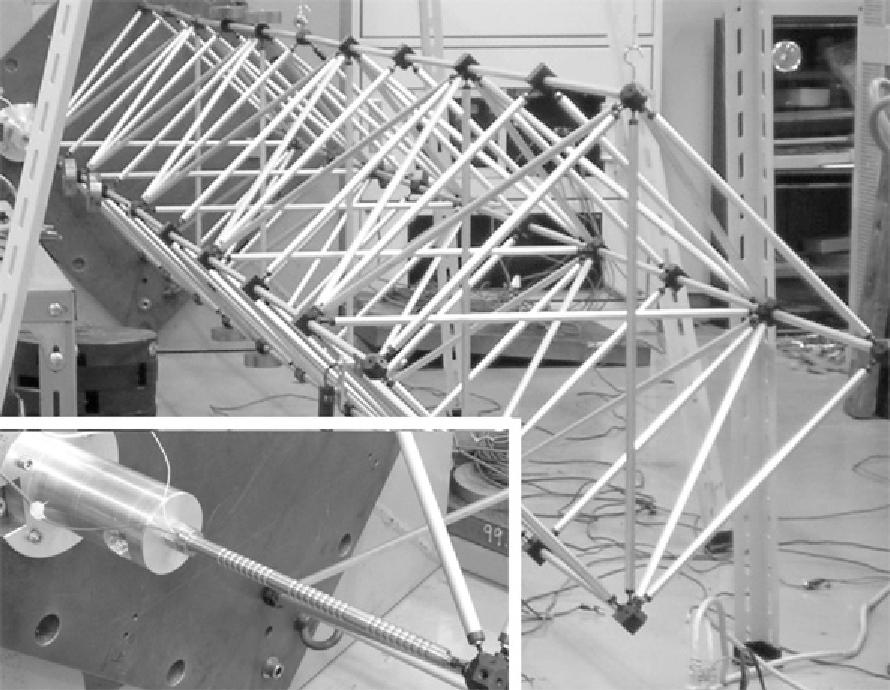
Space truss structure simulating a part of space station
References
[2023] Low-Energy-Consumption Structural Identification with Switching Piezoelectric Semi-Active Input
Hara, Y., Otsuka, K., Makihara, K.
Mechanical Systems and Signal Processing, Vol. 187, Article No. 109914 (Open Access)
[2023] Strategy for Performance Improvement in Piezoelectric Semi-Active Structural System Identification by Excluding Switching Failures using Pseudo-State Feedback
Hara, Y., Tang, T., Otsuka, K., Makihara, K.
Mechanical Systems and Signal Processing, Vol. 187, Article No. 109906
[2022] Self-Sensing Method for Semi-Active Structural Identification by Removing Piecewise Bias from Piezoelectric Voltage
Hara, Y., Tang, T., Otsuka, K., Makihara, K.
Sensors & Actuators: A. Physical, Vol. 347, Article No. 113907
[2022] Semi-Active Switching Vibration Control with Tree-Based Prediction and Optimization Strategy
Abe, M., Hara, Y., Otsuka, K., Makihara, K.
Journal of Intelligent Material Systems and Structures Vol. XX, No. XX, pp. XX - XX
[2021] Comprehensive Predictive Control for Vibration Suppression Based on Piecewise Constant Input Formulation
Takamoto, I., Abe, M., Hara, Y., Otsuka, K., Makihara, K.
Journal of Intelligent Material Systems and Structures Vol. 33, No. 7, pp. 901 - 917
[2020] Predictive Switching Vibration Control Based on Harmonic Input Formulation
Takamoto, I., Abe, M., Hara, Y., Nakahara, T., Otsuka, K., Makihara, K.
Sensors & Actuators: A. Physical Vol. 315, Article No. 112271
1. Vibration Control, Noise Control, Shock Control of Space Structures
We have developed vibration control, acoustic control, and shock control for space structures such as space stations, lunar bases, and artificial satellites. In space, sufficient of power supply is not expected. Thus, an innovative method is required to suppress structural vibration using a self-powered control device. Our laboratory focuses on a truss structure that forms a structural member for next-generation space stations. We have installed a truss structure in our laboratory, which is employed for proof experiments.

Next-generation space station |

Space truss structure simulating a part of space station |
References
[2023] Low-Energy-Consumption Structural Identification with Switching Piezoelectric Semi-Active Input
Hara, Y., Otsuka, K., Makihara, K.
Mechanical Systems and Signal Processing, Vol. 187, Article No. 109914 (Open Access)
[2023] Strategy for Performance Improvement in Piezoelectric Semi-Active Structural System Identification by Excluding Switching Failures using Pseudo-State Feedback
Hara, Y., Tang, T., Otsuka, K., Makihara, K.
Mechanical Systems and Signal Processing, Vol. 187, Article No. 109906
[2022] Self-Sensing Method for Semi-Active Structural Identification by Removing Piecewise Bias from Piezoelectric Voltage
Hara, Y., Tang, T., Otsuka, K., Makihara, K.
Sensors & Actuators: A. Physical, Vol. 347, Article No. 113907
[2022] Semi-Active Switching Vibration Control with Tree-Based Prediction and Optimization Strategy
Abe, M., Hara, Y., Otsuka, K., Makihara, K.
Journal of Intelligent Material Systems and Structures Vol. XX, No. XX, pp. XX - XX
[2021] Comprehensive Predictive Control for Vibration Suppression Based on Piecewise Constant Input Formulation
Takamoto, I., Abe, M., Hara, Y., Otsuka, K., Makihara, K.
Journal of Intelligent Material Systems and Structures Vol. 33, No. 7, pp. 901 - 917
[2020] Predictive Switching Vibration Control Based on Harmonic Input Formulation
Takamoto, I., Abe, M., Hara, Y., Nakahara, T., Otsuka, K., Makihara, K.
Sensors & Actuators: A. Physical Vol. 315, Article No. 112271
2. Energy-Harvesting Using Smart Structures
We cannot solely rely on solar power generation on the moon because night time occurs for up to 14 days.
Therefore, energy harvesting from vibration sources should be explored.
We are developing an energy harvester that is utilized not only in space structures but also vehicles such as airplanes and automobiles.
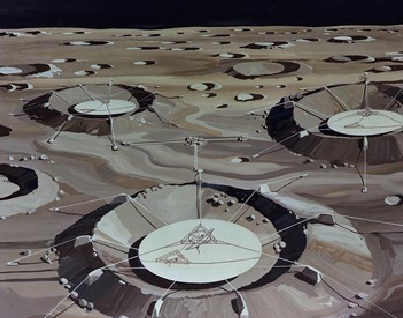
Lunar observation base using moon craters
References
[2023] Energy Harvesting Using Magnetostrictive Transducer Based on Switch Control
Li, A., Goto, K., Kobayashi, Y., Hara, Y., Jia, Y., Shi, Y., Soutis, C., Kurita, H., Narita, F., Otsuka, K., Makihara, K.
Sensors and Actuators: A. Physical, Vol. 355, Article No. 114303 (Open Access)
[2021] Adaptive and Robust Operation with Active Fuzzy Harvester under Nonstationary and Random Disturbance Conditions
Hara, Y., Otsuka, K., Makihara, K.
Sensors, Vol. 21, No. 11, p. 3913 (Open Access)
[2021] Piezoelectric Energy Enhancement Strategy for Active Fuzzy Harvester with Time-Varying and Intermittent Switching
Hara, Y., Zhou, M., Li, A., Otsuka, K., Makihara, K.
Smart Materials and Structures, Vol. 30, No. 1, Article No. 015038
[2020] Self-Sensing State Estimation of SSHI Energy Harvesters
Hara, Y., Yamamoto, Y., Makihara, K.
Journal of Intelligent Material Systems and Structures Vol. 31, No. 20, pp. 2326 - 2341
[2019] Compact, Digital and Self-Powered Piezoelectric Vibration Energy Harvester with Generation Control Using Voltage Measurement Circuit
Hara, Y., Saito, K., Makihara, K.
Sensors & Actuators: A. Physical 299 Article No. 111609
[2017] Analog Self-Powered Harvester Achieving Switching Pause Control to Increase Harvested Energy
Makihara, K., Asahina, K.
Smart Materials and Structures Vol. 26, No. 5, Article No. 055007
[2017] Strategy for Enhancing the Active Harvesting of Piezoelectric Energy
Yoshimizu, K., Yamamoto, Y., Asahina, K., Makihara, K.
Journal of Intelligent Material Systems and Structures Vol. 28, No. 8, pp. 1059 - 1070
2. Energy-Harvesting Using Smart Structures
We cannot solely rely on solar power generation on the moon because night time occurs for up to 14 days. Therefore, energy harvesting from vibration sources should be explored. We are developing an energy harvester that is utilized not only in space structures but also vehicles such as airplanes and automobiles.

Lunar observation base using moon craters
References
[2023] Energy Harvesting Using Magnetostrictive Transducer Based on Switch Control
Li, A., Goto, K., Kobayashi, Y., Hara, Y., Jia, Y., Shi, Y., Soutis, C., Kurita, H., Narita, F., Otsuka, K., Makihara, K.
Sensors and Actuators: A. Physical, Vol. 355, Article No. 114303 (Open Access)
[2021] Adaptive and Robust Operation with Active Fuzzy Harvester under Nonstationary and Random Disturbance Conditions
Hara, Y., Otsuka, K., Makihara, K.
Sensors, Vol. 21, No. 11, p. 3913 (Open Access)
[2021] Piezoelectric Energy Enhancement Strategy for Active Fuzzy Harvester with Time-Varying and Intermittent Switching
Hara, Y., Zhou, M., Li, A., Otsuka, K., Makihara, K.
Smart Materials and Structures, Vol. 30, No. 1, Article No. 015038
[2020] Self-Sensing State Estimation of SSHI Energy Harvesters
Hara, Y., Yamamoto, Y., Makihara, K.
Journal of Intelligent Material Systems and Structures Vol. 31, No. 20, pp. 2326 - 2341
[2019] Compact, Digital and Self-Powered Piezoelectric Vibration Energy Harvester with Generation Control Using Voltage Measurement Circuit
Hara, Y., Saito, K., Makihara, K.
Sensors & Actuators: A. Physical 299 Article No. 111609
[2017] Analog Self-Powered Harvester Achieving Switching Pause Control to Increase Harvested Energy
Makihara, K., Asahina, K.
Smart Materials and Structures Vol. 26, No. 5, Article No. 055007
[2017] Strategy for Enhancing the Active Harvesting of Piezoelectric Energy
Yoshimizu, K., Yamamoto, Y., Asahina, K., Makihara, K.
Journal of Intelligent Material Systems and Structures Vol. 28, No. 8, pp. 1059 - 1070
3. Experiments for Space-Debris Impacts
The impact of space debris and meteorites is a serious issue for space structures.
We have implemented measures to mitigate hypervelocity impact in collaboration with JAXA.
We are investigating the use of a conductive tether system for debris removal.
We are conducting research on the durability of inflatable structures, which are attracting attention as space structures, against space debris collisions and meteorite collisions, from the viewpoint of experimental verification using large impact experiments.

Hypervelocity impact experiments conducted in JAXA
References
[2021] Assessment of Space Debris Collisions Against Spacecraft with Deorbit Devices
Tomizaki, H., Kobayashi, R., Suzuki, M., Karasawa, N., Hasegawa, S., Makihara, K.
Advances in Space Research, Vol. 67, No. 5, pp. 1526-1534
[2020] Damage of Twisted Tape Tethers on Debris Collision
Uwamino, Y., Fujiwara, M., Tomizaki, H., Ohtani, K., Makihara, K.
International Journal of Impact Engineering Vol. 137, Article No. 103440
[2018] Structural Evaluation for Electrodynamic Tape Tethers Against Hypervelocity Space Debris Impacts
Makihara, K., Kondo, S.
AIAA, Journal of Spacecraft and Rockets Vol. 55, No. 2, pp. 462 - 472
[2017] Bayesian Cloud Extraction for Assessment of Space-Debris Impact Using Conditional Entropy
Makihara, K., Oki, Y.
AIAA, Journal of Spacecraft and Rockets Vol. 54, No. 6, pp. 1235 - 1245
[2016] Survival Probability of Hollow Cylindrical Mesh Tether Under Space-Debris Impact
Makihara, K., Norihiko Matsumoto
AIAA, Journal of Spacecraft and Rockets Vol. 53, No. 3, pp. 520 - 527
[2016] Survivability Evaluation of Electrodynamic Tethers Considering Dynamic Fracture in Space-Debris Impact
Makihara, K., Takahashi, R.
AIAA, Journal of Spacecraft and Rockets Vol. 53, No. 1, pp. 209 - 216
3. Experiments for Space-Debris Impacts
The impact of space debris and meteorites is a serious issue for space structures. We have implemented measures to mitigate hypervelocity impact in collaboration with JAXA. We are investigating the use of a conductive tether system for debris removal. We are conducting research on the durability of inflatable structures, which are attracting attention as space structures, against space debris collisions and meteorite collisions, from the viewpoint of experimental verification using large impact experiments.

Hypervelocity impact experiments conducted in JAXA
References
[2021] Assessment of Space Debris Collisions Against Spacecraft with Deorbit Devices
Tomizaki, H., Kobayashi, R., Suzuki, M., Karasawa, N., Hasegawa, S., Makihara, K.
Advances in Space Research, Vol. 67, No. 5, pp. 1526-1534
[2020] Damage of Twisted Tape Tethers on Debris Collision
Uwamino, Y., Fujiwara, M., Tomizaki, H., Ohtani, K., Makihara, K.
International Journal of Impact Engineering Vol. 137, Article No. 103440
[2018] Structural Evaluation for Electrodynamic Tape Tethers Against Hypervelocity Space Debris Impacts
Makihara, K., Kondo, S.
AIAA, Journal of Spacecraft and Rockets Vol. 55, No. 2, pp. 462 - 472
[2017] Bayesian Cloud Extraction for Assessment of Space-Debris Impact Using Conditional Entropy
Makihara, K., Oki, Y.
AIAA, Journal of Spacecraft and Rockets Vol. 54, No. 6, pp. 1235 - 1245
[2016] Survival Probability of Hollow Cylindrical Mesh Tether Under Space-Debris Impact
Makihara, K., Norihiko Matsumoto
AIAA, Journal of Spacecraft and Rockets Vol. 53, No. 3, pp. 520 - 527
[2016] Survivability Evaluation of Electrodynamic Tethers Considering Dynamic Fracture in Space-Debris Impact
Makihara, K., Takahashi, R.
AIAA, Journal of Spacecraft and Rockets Vol. 53, No. 1, pp. 209 - 216
4. Tensegrity for Space Structures
We are creating a new space structure using the ultra-lightweight variable structure "tensegrity" composed of rods and threads.
Tensegrity is a next-generation structure with high strength, light weight, impact resistance, and high storage capacity
It is expected to be used as a lunar base, a Mars base, and a planetary probe.
Our laboratory is working on the realization of the tensegrity space structure from both experimental and theoretical perspectives.
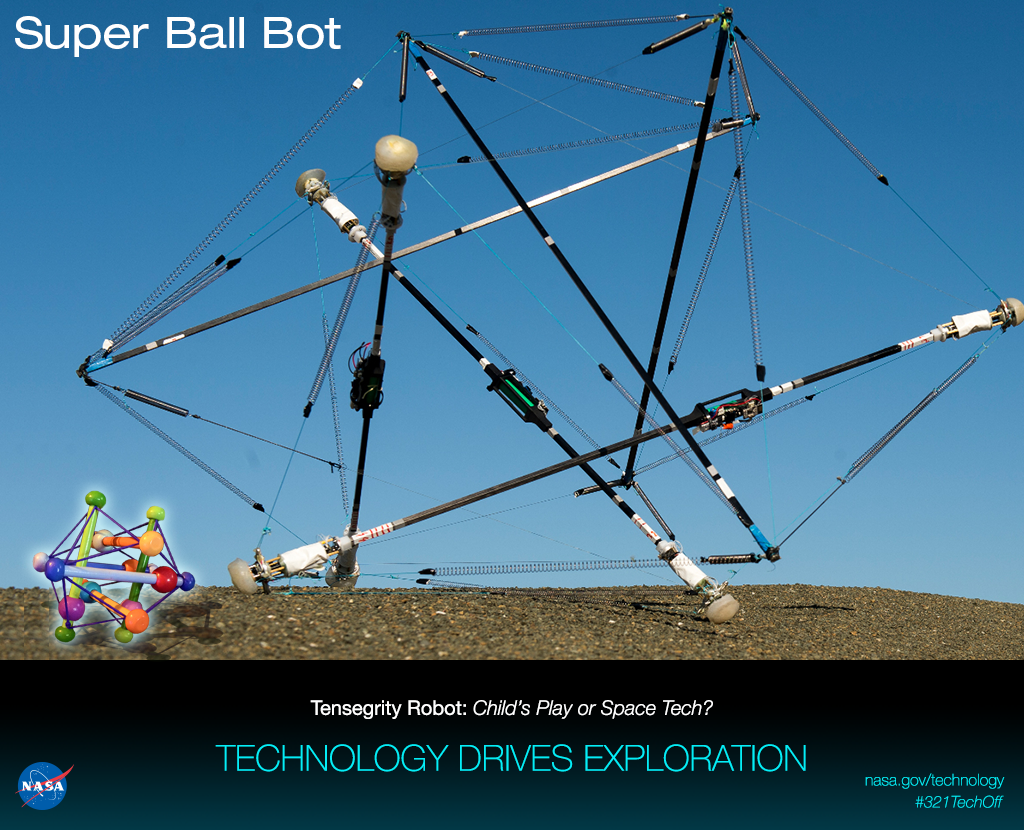
Tensegrity©NASA
4. Tensegrity for Space Structures
We are creating a new space structure using the ultra-lightweight variable structure "tensegrity" composed of rods and threads. Tensegrity is a next-generation structure with high strength, light weight, impact resistance, and high storage capacity It is expected to be used as a lunar base, a Mars base, and a planetary probe. Our laboratory is working on the realization of the tensegrity space structure from both experimental and theoretical perspectives.

Tensegrity©NASA
5. Aeroelsatic Energy Harvesting
On Mars, which is far from the Sun, sufficient electricity generation is important.
In our laboratory, we have started research on aeroelastic energy harvesting, which generates high power from vibrations caused by frequent gusts and strong winds on Mars.
We have built a demonstration wind tunnel in our laboratory and are working on both experimental and theoretical aspects.
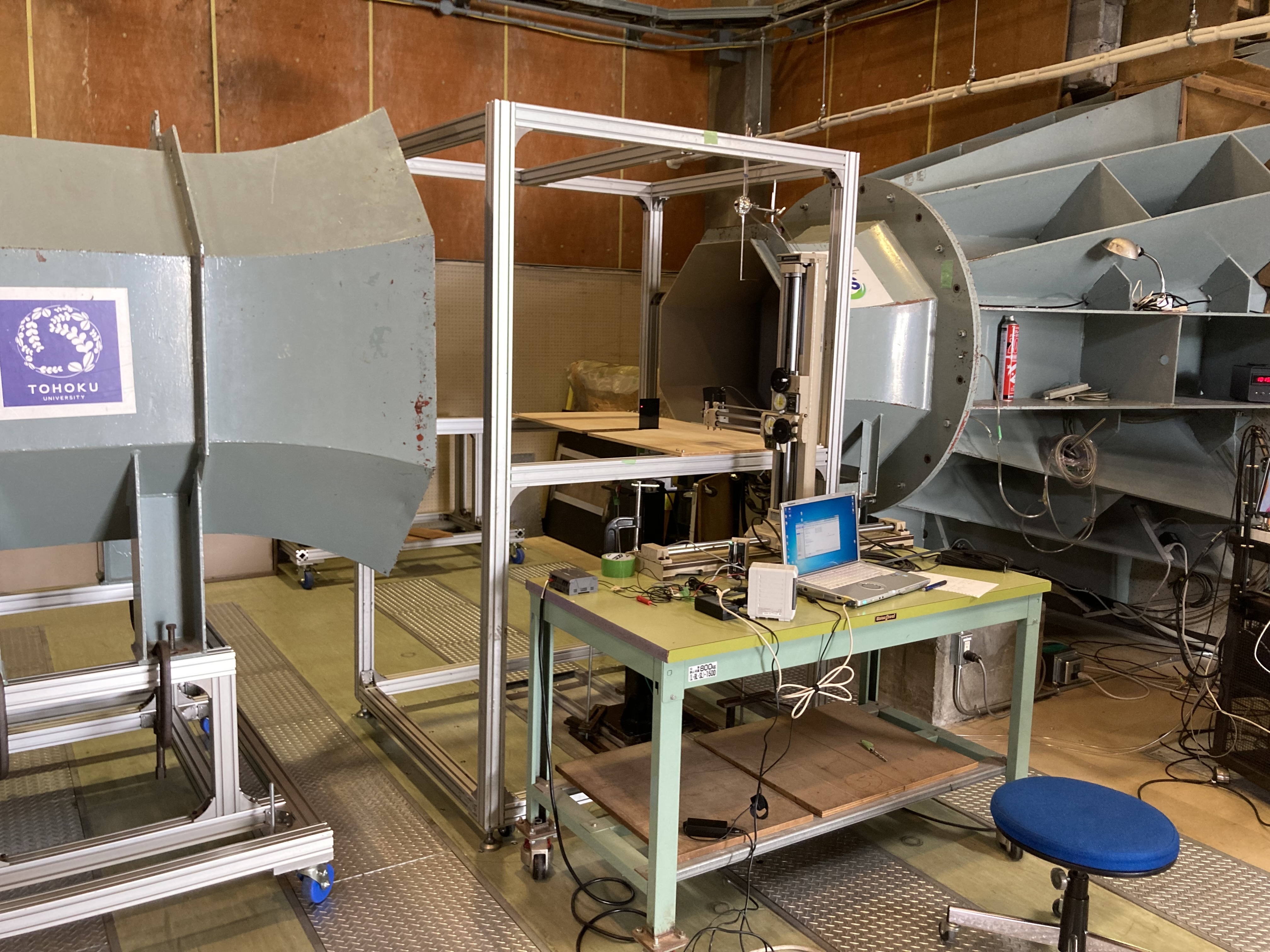
IFS Wind Tunnel
5. Aeroelsatic Energy Harvesting
On Mars, which is far from the Sun, sufficient electricity generation is important. In our laboratory, we have started research on aeroelastic energy harvesting, which generates high power from vibrations caused by frequent gusts and strong winds on Mars. We have built a demonstration wind tunnel in our laboratory and are working on both experimental and theoretical aspects.

IFS Wind Tunnel
6. Aeroservoelastic Modeling for Morphing Wings
Next-generation aircraft is expected to have a morphing wing to achieve higher fuel efficiency and compactness.
We integrated three fields (fluid, structure, and control) to establish a coupling model for variable wings.
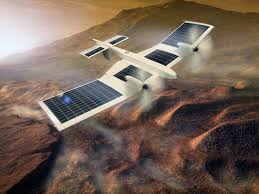
Mars aircraft©JAXA
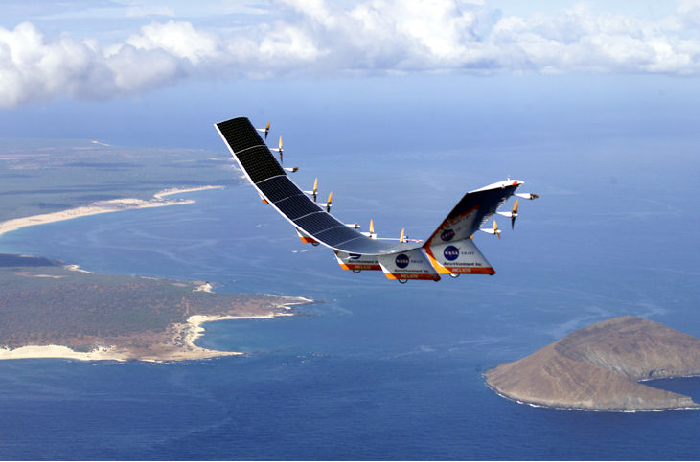
Flexible wing aircraft©NASA
References
[2022] Joint Parameters for Strain-Based Geometrically Nonlinear Beam Formulation: Multibody Analysis and Experiment
Otsuka, K., Dong, S., Fujita, K., Nagai, H., Makihara, K.
Journal of Sound and Vibration, Vol. 538, Article No. 117241 (Open Access)
[2022] Consistent Strain-Based Multifidelity Modeling for Geometrically Nonlinear Beam Structures
Otsuka, K., Wang, Y., Fujita, K., Nagai, H., Makihara, K.
ASME Journal of Computational and Nonlinear Dynamics, Vol. 17, No. 11, Article No. 111003 (Open Access)
[2022] Nonlinear Aeroelastic Analysis of High-Aspect-Ratio Wings with a Low-Order Propeller Model
Otsuka, K., Del Carre, A., Palacios, R.
AIAA Journal of Aircraft, Vol. 59, No. 2, pp. 293-306 (Open Access)
[2021] Absolute Nodal Coordinate Formulation with Vector-Strain Transformation for High Aspect Ratio Wings
Otsuka, K., Wang, Y., Makihara, K.
ASME Journal of Computational and Nonlinear Dynamics, Vol. 16, No. 1, Article No. 011007
[2021] Three-Dimensional Aeroelastic Model for Successive Analyses of High-Aspect-Ratio Wings
Otsuka, K., Wang, Y., Makihara, K.
ASME Journal of Vibration and Acoustics, Vol. 143, No. 6, Article No. 061006
[2019] Versatile Absolute Nodal Coordinate Formulation Model for Dynamic Folding Wing Deployment and Flutter Analyses
Otsuka, K., Wang, Y., Makihara, K.
ASME Journal of Vibration and Acoustics Vol. 141, No. 1, Article No. 011014
[2019] Multifidelity Modeling of Deployable Wings: Multibody Dynamic Simulation and Wind Tunnel Experiment
Otsuka, K., Wang, Y., Fujita, K., Nagai, H., Makihara, K.
AIAA Journal Vol. 57, No. 10, pp. 4300 - 4311
[2017] Deployable wing Model Considering Structural Flexibility and Aerodynamic Unsteadiness for Deployment System Design
Otsuka, K., Wang, Y., Makihara, K.
Journal of Sound and Vibration Vol. 408, pp. 105 - 122
[2016] Aeroelastic Deployable wing Simulation Considering Rotation Hinge Joint based on Flexible Multibody Dynamics
Otsuka, K., Makihara, K.
Journal of Sound and Vibration Vol. 369, pp. 147 - 167
6. Aeroservoelastic Modeling for Morphing Wings
Next-generation aircraft is expected to have a morphing wing to achieve higher fuel efficiency and compactness. We integrated three fields (fluid, structure, and control) to establish a coupling model for variable wings.

Mars aircraft©JAXA |

Flexible wing aircraft©NASA |
References
[2022] Joint Parameters for Strain-Based Geometrically Nonlinear Beam Formulation: Multibody Analysis and Experiment
Otsuka, K., Dong, S., Fujita, K., Nagai, H., Makihara, K.
Journal of Sound and Vibration, Vol. 538, Article No. 117241 (Open Access)
[2022] Consistent Strain-Based Multifidelity Modeling for Geometrically Nonlinear Beam Structures
Otsuka, K., Wang, Y., Fujita, K., Nagai, H., Makihara, K.
ASME Journal of Computational and Nonlinear Dynamics, Vol. 17, No. 11, Article No. 111003 (Open Access)
[2022] Nonlinear Aeroelastic Analysis of High-Aspect-Ratio Wings with a Low-Order Propeller Model
Otsuka, K., Del Carre, A., Palacios, R.
AIAA Journal of Aircraft, Vol. 59, No. 2, pp. 293-306 (Open Access)
[2021] Absolute Nodal Coordinate Formulation with Vector-Strain Transformation for High Aspect Ratio Wings
Otsuka, K., Wang, Y., Makihara, K.
ASME Journal of Computational and Nonlinear Dynamics, Vol. 16, No. 1, Article No. 011007
[2021] Three-Dimensional Aeroelastic Model for Successive Analyses of High-Aspect-Ratio Wings
Otsuka, K., Wang, Y., Makihara, K.
ASME Journal of Vibration and Acoustics, Vol. 143, No. 6, Article No. 061006
[2019] Versatile Absolute Nodal Coordinate Formulation Model for Dynamic Folding Wing Deployment and Flutter Analyses
Otsuka, K., Wang, Y., Makihara, K.
ASME Journal of Vibration and Acoustics Vol. 141, No. 1, Article No. 011014
[2019] Multifidelity Modeling of Deployable Wings: Multibody Dynamic Simulation and Wind Tunnel Experiment
Otsuka, K., Wang, Y., Fujita, K., Nagai, H., Makihara, K.
AIAA Journal Vol. 57, No. 10, pp. 4300 - 4311
[2017] Deployable wing Model Considering Structural Flexibility and Aerodynamic Unsteadiness for Deployment System Design
Otsuka, K., Wang, Y., Makihara, K.
Journal of Sound and Vibration Vol. 408, pp. 105 - 122
[2016] Aeroelastic Deployable wing Simulation Considering Rotation Hinge Joint based on Flexible Multibody Dynamics
Otsuka, K., Makihara, K.
Journal of Sound and Vibration Vol. 369, pp. 147 - 167
7. Flexible Multibody Dynamics for Aerospace Structures
In order to realize a variable space structure with large deformation and deployment behavior, an innovative structural analysis theory is required.
In our laboratory, we are creating an innovative "flexible multibody dynamics analysis method" and demonstrating experiments toward the realization of the next-generation variable space structure.
In recent years, we have been accelerating research especially on rotating space structures.
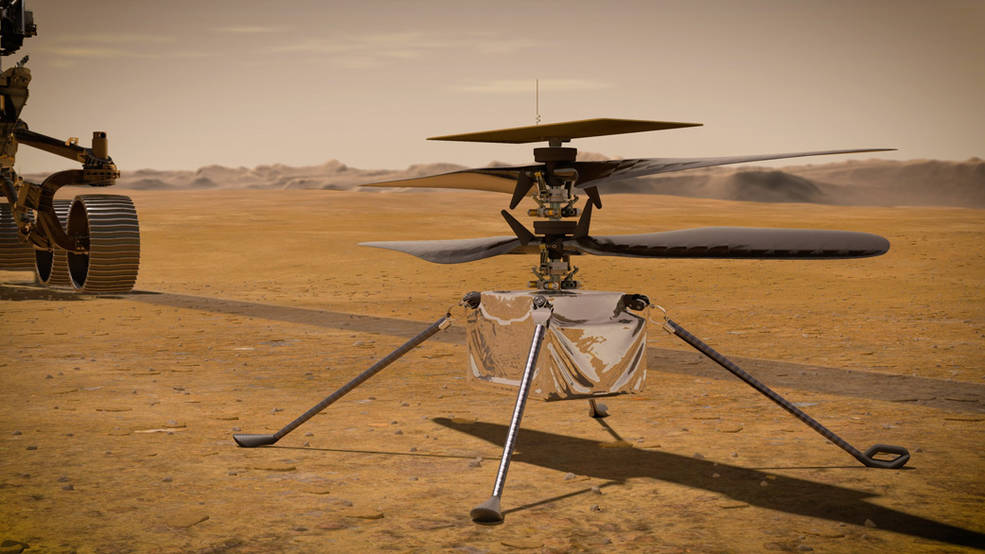
Mars helicopter
Credits: NASA/JPL-Caltech
References
[2023] Hamiltonian Formulation with Reduced Variables for Flexible Multibody Systems Under Linear Constraints: Theory and Experiment
Dong, S., Otsuka, K., Makihara, K.
Journal of Sound and Vibration, Vol. 547, Article No. 117535
[2022] Strain-Based Geometrically Nonlinear Beam Formulation for Rigid-Flexible Multibody Dynamic Analysis
Otsuka, K., Wang, Y., Palacios, R., Makihara, K.
AIAA Journal Vol. 60, No. 8, pp. 4954 - 4968 (Open Access)
[2022] Dynamics and Energy Analysis of Nonequatorial Space Elevator Using Three-Dimensional Nonlinear Finite Element Method Extended to Noninertial Coordinate System
Kuzuno, R., Dong, S., Okada, T., Otsuka, K., Makihara, K.
IEEE Access Vol. 10, pp. 43964 - 43980 (Open Access)
[2022] Recent Advances in the Absolute Nodal Coordinate Formulation: Literature Review from 2012 to 2020
Otsuka, K., Makihara, K., Sugiyama, H.
ASME Journal of Computational and Nonlinear Dynamics, Vol. 17, No. 8, Article No. 080803 (Open Access)
[2019] Absolute Nodal Coordinate Beam Element for Modeling Flexible and Deployable Aerospace Structures
Otsuka, K., Makihara, K.
AIAA Journal Vol. 57, No. 3, pp. 1343 - 1346
[2018] Deployment Simulation Using Absolute Nodal Coordinate Plate Element for Next-Generation Aerospace Structures
Otsuka, K., Makihara, K.
AIAA Journal Vol. 56, No. 3, pp. 1266 - 1276
7. Flexible Multibody Dynamics for Aerospace Structures
In order to realize a variable space structure with large deformation and deployment behavior, an innovative structural analysis theory is required. In our laboratory, we are creating an innovative "flexible multibody dynamics analysis method" and demonstrating experiments toward the realization of the next-generation variable space structure. In recent years, we have been accelerating research especially on rotating space structures.

Mars helicopter
Credits: NASA/JPL-Caltech
References
[2023] Hamiltonian Formulation with Reduced Variables for Flexible Multibody Systems Under Linear Constraints: Theory and Experiment
Dong, S., Otsuka, K., Makihara, K.
Journal of Sound and Vibration, Vol. 547, Article No. 117535
[2022] Strain-Based Geometrically Nonlinear Beam Formulation for Rigid-Flexible Multibody Dynamic Analysis
Otsuka, K., Wang, Y., Palacios, R., Makihara, K.
AIAA Journal Vol. 60, No. 8, pp. 4954 - 4968 (Open Access)
[2022] Dynamics and Energy Analysis of Nonequatorial Space Elevator Using Three-Dimensional Nonlinear Finite Element Method Extended to Noninertial Coordinate System
Kuzuno, R., Dong, S., Okada, T., Otsuka, K., Makihara, K.
IEEE Access Vol. 10, pp. 43964 - 43980 (Open Access)
[2022] Recent Advances in the Absolute Nodal Coordinate Formulation: Literature Review from 2012 to 2020
Otsuka, K., Makihara, K., Sugiyama, H.
ASME Journal of Computational and Nonlinear Dynamics, Vol. 17, No. 8, Article No. 080803 (Open Access)
[2019] Absolute Nodal Coordinate Beam Element for Modeling Flexible and Deployable Aerospace Structures
Otsuka, K., Makihara, K.
AIAA Journal Vol. 57, No. 3, pp. 1343 - 1346
[2018] Deployment Simulation Using Absolute Nodal Coordinate Plate Element for Next-Generation Aerospace Structures
Otsuka, K., Makihara, K.
AIAA Journal Vol. 56, No. 3, pp. 1266 - 1276
8. Topology Optimization for Aerospace Structures
In order to realize a large-scale aerospace structures, we develop a novel auto-design method for efficient structural members.
Our approach facilitates manufacturing and assembling the auto-designed structural members.
References
[2023] Moving Morphable Multi Components Introducing Intent of Designer in Topology Optimization
Otsuka, K., Dong, S., Kuzuno, R., Sugiyama, H., Makihara, K.
AIAA Journal, Vol. XX, No. XX, pp. XX-XX (Open Access)
8. Topology Optimization for Aerospace Structures
In order to realize a large-scale aerospace structures, we develop a novel auto-design method for efficient structural members. Our approach facilitates manufacturing and assembling the auto-designed structural members.
References
[2023] Moving Morphable Multi Components Introducing Intent of Designer in Topology Optimization
Otsuka, K., Dong, S., Kuzuno, R., Sugiyama, H., Makihara, K.
AIAA Journal, Vol. XX, No. XX, pp. XX-XX (Open Access)
